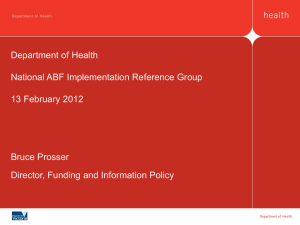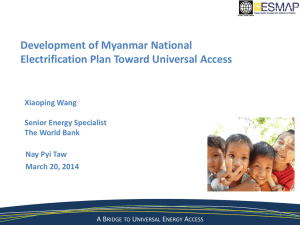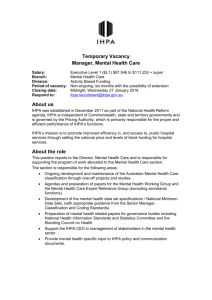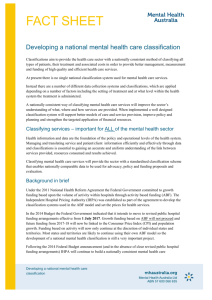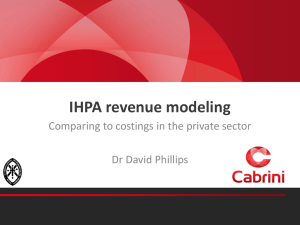National Activity Based Funding Implementation Reference Group
advertisement
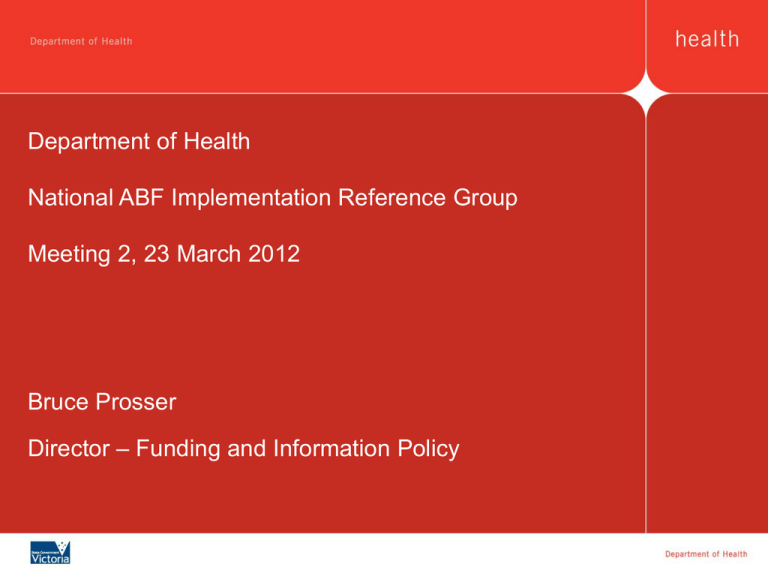
Department of Health National ABF Implementation Reference Group Meeting 2, 23 March 2012 Bruce Prosser Director – Funding and Information Policy Overview of topics Update since previous meeting Key milestones and timelines Structure of new funding arrangements Options for the State funding contribution Payments system 2 Timelines IHPA National Efficient Price (NEP) Determination (establishes Commonwealth funding distribution) Includes NEP, cost weights, details of funding model, block funding criteria, scope of services, indexation • 30 March – IHPA publishes draft NEP determination • 12 April – ABF implementation reference group • 30 April – Draft Victorian Government response due with Minister • 14 May – Due date for response to IHPA (45 calendar days after release) • Late May – IHPA publishes final NEP determination 3 Timelines Finalisation of State Government funding distribution • 30 March – IHPA publishes draft NEP determination • April – Commence discussions on Health Service budgets • 1 May - Victorian State budget outcome known • End May - IHPA publishes final NEP determination • Late June – Provide Health Services with modelled budgets 4 Timelines Discussion - Timelines • Health Services will need to come to terms with changes to cost weights and implied budgets due to : adoption of new ABF models for acute admitted, emergency and specialist outpatients (new under NHRA) use of national cost data rather than Victorian (new under NHRA) newer cost data (as usual) Victorian budget outcomes (as usual) • The combined impact of these changes will only be able to be understood once the NEP determination and Victorian state budget are finalised. 5 Structure of new funding arrangements Key issues at interface of NEP Determination and Victorian Government funding distribution • Level at which the NEP is set • New ABF models • A single NEP for multiple service streams • A new approach to pricing private patients in public hospitals These issues are discussed in turn in the following slides 6 Structure of new funding arrangements Level at which NEP is set • The IHPA appears likely to set a NEP that is significantly higher than the price implied by the average Victorian cost data, due to the inclusion of national data in the calculation. While this could be interpreted as a funding increase to the Victorian system, in practice: Commonwealth price paid + State price paid < 100% NEP as there is a capped Commonwealth funding envelope for 201213 and 2013-14 and the NEP is tied to average cost, not current funding levels. • This will manifest in an apparent ‘reduced’ percentage of the NEP paid by the State and Commonwealth to hospitals. 7 Structure of new funding arrangements – New ABF models Service Stream Current Victorian model National ABF model (from 2012-13) Acute Admitted WIES – based on Diagnosis Related Groups (DRG) classification system. Features include •copayments (e.g. ICU) •HITH adjustment •renal capitation DRG-based model, simplified •diluted ICU copayment •no HITH adjustment •no capitation payment Emergency Department Non-Admitted Emergency Services Grant (NAESG) – covers approved 24 hour emergency departments. Admitted emergency paid using WIES. Urgency Related Groups (URG) classification system •covers admitted and non-admitted. Specialist Outpatients VACS – classification for medical outpatient clinics only. Allied health clinics funded using a flat rate. Tier 2 clinic classification system •classification for both medical and allied health clinics (includes Radiotherapy) •Commonwealth will not fund services (bundled encounters) already funded in part or in full through MBS, PBS 8 Structure of new funding arrangements Discussion - new funding models • The new funding models appear likely to generate significant implied funding redistribution across health services. • The preferred option for Victoria in managing these distortions is to pay the NEP at a reduced level. This will enable the payment of transitional block grants to maintain continuity in Health Service Budgets. • Given that some of the new ABF models are more robust than others, the price reduction would need to be greater in some service streams (i.e. Outpatients and Emergency Departments) 9 Structure of new funding arrangements Single NEP for multiple service streams • The IHPA appears likely to propose a single price for all service streams. This price would be anchored to the average acute admitted price to maintain the stability of the price over time. • Under this approach, the new ABF models appear likely to result in an implied funding redistribution across service streams (i.e. more funding to flow to Emergency Departments and Outpatients at expense of Acute Admitted). • This is due to ED funding for admitted patients being removed from the admitted price and paid instead through an ED activity payment for both admitted and non-admitted patients • Also newer and less comprehensive datasets underpinning ED and outpatient cost weights is likely to overstate their relative weight. 10 Structure of new funding arrangements Discussion - single NEP for multiple service streams • The preferred option for Victoria in maintaining continuity in service stream funding is to apply adjustments to the percentage of the ‘single’ price paid by the state. • The level of these adjustments would need to vary according to service stream (i.e., greater reduction in the price paid for Emergency Departments and Outpatients). 11 Structure of new funding arrangements Private patients • The IHPA appears likely to propose a set of separate private patient weights. They advise that this is due to observed variation between DRGs in the level of private patient costs/revenue. • This is in contrast to a single private patients price as is currently in place in Victoria. 12 Structure of new funding arrangements Discussion – private patients • In its response to the IHPA’s draft NEP determination, Victoria intends to oppose the creation of separate private patient weights, in favour of a single private patient price. • In the event that separate private patient weights are established, what do you think the impact will be on: Health Services; private insurers; Doctors undertaking private work? 13 Options for the State funding contribution The need to maintain stability in Health Service Budgets • The previous slides highlight that new funding arrangements imply a significant redistribution of funding between health services and service streams. • Implementing these implied funding shifts is not justified based on these new and untested ABF models. States as system managers must minimise risk of disruption to Health Services through a combination of: transitional funding (block grants); and adjustment to the State price component, to ‘afford’ the transitional funding in a constrained budget environment. • Options for the structuring the State funding contribution are outlined in the following slides. 14 Specified Grants • The intention of ABF reform is to wherever possible remove specified grants and roll into price. • IHPA draft pricing framework included two broad criteria for block funding being: • – The technical requirement for ABF are not met – The absence of economies of scale. It is proposed in 12/13 to continue the following specified grants: – National Funded Centres – Statewide Services – New Technology – Program Initiatives – Contractual arrangements – ICT 15 Options for the State funding contribution – Block component Options Pros Cons Single large transitional block grant for each health service. Increased simplicity. Reduced transparency. Earmarking of transitional contribution for specific program areas. Relatively simple, transparent. Earmarking will not be able to cover all program areas, which may lead to confusion. For services provided by a third party but included in price, cost could be attributed to individual health service and paid for through ‘negative grant’ to Health Service, e.g. for Chaplaincy. Consistent with practice in other jurisdictions (e.g. centralised payroll). In Victoria, a limited number of third party payments are included in price, adjustments may be administratively burdensome given their size. 16 Options for the State funding contribution – Price component Options Pros Cons Preferred Option: Reduced % of NEP paid to health services to ‘afford’ transitional block funding. - Management of volatility to Health Services’ budget will occur centrally. - Price paid to the Health Services will be far lower than the NEP. Greater % NEP with negative grants to ‘afford’ transitional block funding. - Health Services will be notionally paid at a level that is closer to the NEP. - Some health services (‘winners’) will have funding retracted to compensate other health services (‘losers’). Separate price for each health service - Increased ability to target Health Service ABF component. - Inequity in price setting which is model, rather than cost driven. Decreased ability to compare funding between health services. - Not adopt the national ED and OP ABF model for the State price component, pay state contribution through block grant. - Mitigate the risk of amplifying perverse pricing (cost weight) signals through insufficiently robust ABF models. 17 - Increased administrative burden Reduced clarity of objectives and activity targets for Health Services. Payments system National Funding Body • The National Funding Body will make payments out of the National Funding Pool (for ABF activities) directly to health services. This will encompass both State and Commonwealth funding. Administered by a single National Administrator. • State managed fund will be created to manage teaching, training, research and block (specified) grants. • Direct DH funding to Health Services will continue for the provision of capital and services provided in a community setting (for example dental services, primary care, Home and Community Care (HACC), Residential Aged). • Funding from third parties such as the Commonwealth for specific functions (pharmaceuticals, TAC and WorkCover for compensable payments) to continue. 18 Payments system Payment Flows • States will control the timing and amount that flows out of the National Funding Pool to LHNs • Commonwealth contribution to the Pool occur once a month. Depending on timing, States may be required to cashflow Commonwealth component. • Victoria is reviewing the payment arrangements to health services (or LHNs) to ensure there is no unintended cashflow or liquidity issues. • Health services will continue receive aggregate payment information from the State, encompassing all payment sources. 19 Payments system Principles and key issues Victoria is continuing to work with the Commonwealth and our jurisdictional colleagues to develop and agree to a practical operating model for the Pool, including addressing the following key principles: 1. The State will continue to be responsible for determining funding levels to hospitals in accordance with service agreements. 2. The State continues current system and performance management arrangements, without interference in funding flexibility or additional reporting burdens. 3. There will be clear, accountable, and efficient funding and acquittal arrangements in place. 4. The arrangements maintain simplicity and minimal bureaucracy (we’ll try). 5. Payment integrity and reliability of payments from the Pool to LHNs continue to occur successfully and uninterrupted. 20 Next Steps Proposed meeting dates • 12 April 2012 (scheduled) • 23 April 2012 (out of session feedback on draft response) • 15 May 2012 (TBC) • 13 June 2012 (TBC) 21

